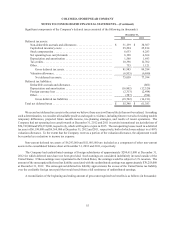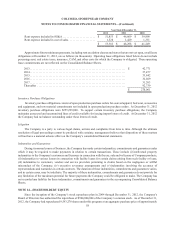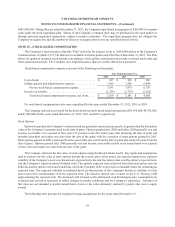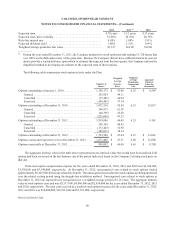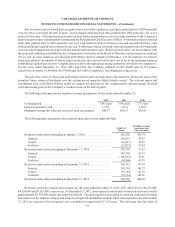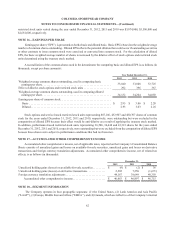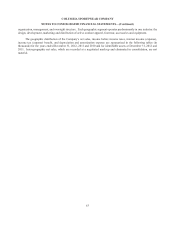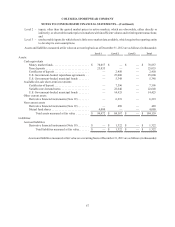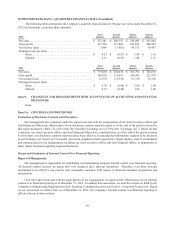Columbia Sportswear 2012 Annual Report Download - page 63
Download and view the complete annual report
Please find page 63 of the 2012 Columbia Sportswear annual report below. You can navigate through the pages in the report by either clicking on the pages listed below, or by using the keyword search tool below to find specific information within the annual report.
COLUMBIA SPORTSWEAR COMPANY
NOTES TO CONSOLIDATED FINANCIAL STATEMENTS—(Continued)
59
$441,443,000. During the year ended December 31, 2012, the Company repurchased an aggregate of $206,000 of common
stock under the stock repurchase plan. Shares of the Company’s common stock may be purchased in the open market or
through privately negotiated transactions, subject to market conditions. The repurchase program does not obligate the
Company to acquire any specific number of shares or to acquire shares over any specified period of time.
NOTE 15—STOCK-BASED COMPENSATION
The Company’s stock incentive plan (the “Plan”) provides for issuance of up to 10,400,000 shares of the Company’s
Common Stock, of which 2,573,748 shares were available for future grants under the Plan at December 31, 2012. The Plan
allows for grants of incentive stock options, non-statutory stock options, restricted stock awards, restricted stock units and
other stock-based awards. The Company uses original issuance shares to satisfy share-based payments.
Stock-based compensation expense consisted of the following (in thousands):
Year Ended December 31,
2012 2011 2010
Cost of sales . . . . . . . . . . . . . . . . . . . . . . . . . . . . . . . . . . . . . . . $ 287 $ 282 $ 286
Selling, general and administrative expense . . . . . . . . . . . . . . . 7,546 7,588 6,444
Pre-tax stock-based compensation expense. . . . . . . . . . . . 7,833 7,870 6,730
Income tax benefits . . . . . . . . . . . . . . . . . . . . . . . . . . . . . . . . . . (2,724) (2,729) (2,162)
Total stock-based compensation expense, net of tax. . . . . $ 5,109 $ 5,141 $ 4,568
No stock-based compensation costs were capitalized for the years ended December 31, 2012, 2011 or 2010.
The Company realized a tax benefit for the deduction from stock-based award transactions of $3,410,000, $4,702,000,
and $1,909,000 for the years ended December 31, 2012, 2011 and 2010, respectively.
Stock Options
Options to purchase the Company’s common stock are granted at exercise prices equal to or greater than the fair market
value of the Company’s common stock on the date of grant. Options granted after 2000 and before 2009 generally vest and
become exercisable over a period of four years (25 percent on the first anniversary date following the date of grant and
monthly thereafter) and expire ten years from the date of the grant, with the exception of most options granted in 2005.
Most options granted in 2005 vested and became exercisable one year from the date of grant and expire ten years from the
date of grant. Options granted after 2008 generally vest and become exercisable ratably on an annual basis over a period
of four years and expire ten years from the date of the grant.
The Company estimates the fair value of stock options using the Black-Scholes model. Key inputs and assumptions
used to estimate the fair value of stock options include the exercise price of the award, the expected option term, expected
volatility of the Company’s stock over the option’s expected term, the risk-free interest rate over the option’s expected term,
and the Company’s expected annual dividend yield. The option's expected term is derived from historical option exercise
behavior and the option's terms and conditions, which the Company believes provides a reasonable basis for estimating an
expected term. The expected volatility is estimated based on observations of the Company's historical volatility over the
most recent term commensurate with the expected term. The risk-free interest rate is based on the U.S. Treasury yield
approximating the expected term. The dividend yield is based on the anticipated cash dividend payouts. Assumptions are
evaluated and revised as necessary to reflect changes in market conditions and the Company’s experience. Estimates of
fair value are not intended to predict actual future events or the value ultimately realized by people who receive equity
awards.
The following table presents the weighted average assumptions for the years ended December 31:








